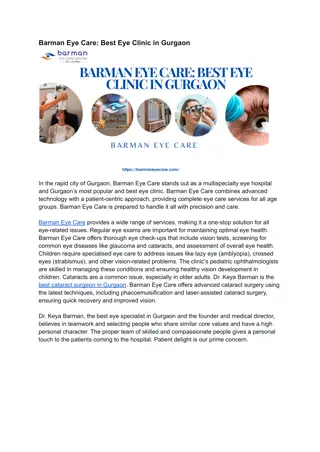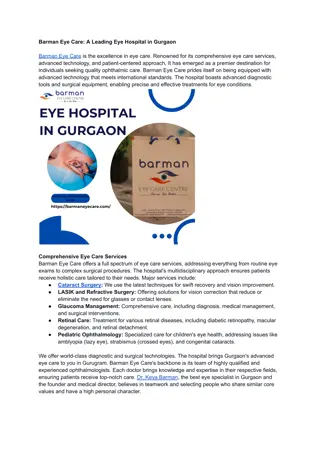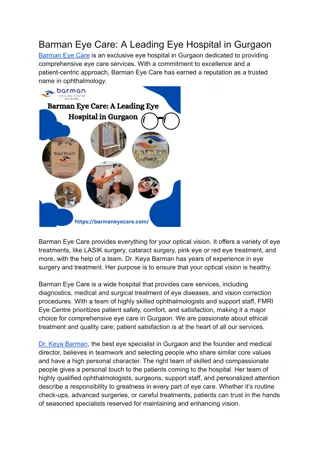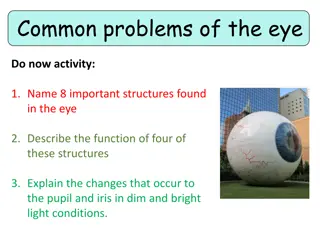Comprehensive Overview of Eye Tracking: Techniques, Applications, and Analysis
Eye tracking is the process of measuring eye movements to analyze attention, cognition, and behavior. This overview delves into the taxonomy of eye movements, various eye tracking techniques like Electro-oculography and Video-Oculography, the data collected, and its visualization methods. Understand the applications of eye tracking in research, marketing, user experience, and more.
Download Presentation

Please find below an Image/Link to download the presentation.
The content on the website is provided AS IS for your information and personal use only. It may not be sold, licensed, or shared on other websites without obtaining consent from the author.If you encounter any issues during the download, it is possible that the publisher has removed the file from their server.
You are allowed to download the files provided on this website for personal or commercial use, subject to the condition that they are used lawfully. All files are the property of their respective owners.
The content on the website is provided AS IS for your information and personal use only. It may not be sold, licensed, or shared on other websites without obtaining consent from the author.
E N D
Presentation Transcript
Analyzing Eye Tracking Data MMC9503 Weimei Sun
Outline Introduction of Eye-tracking Taxonomy of Eye Movements Eye-tracking Techniques The Data of Eye-tracker Analysis of Eye-tracking Data Eye-tracking Applications
Eye-tracking Eye-tracking is the process of measuring : 1. The point of gaze (where one is looking) or the the point of regard. 2. The motion of an eye relative to the head.
Taxonomy of Eye Movements Fixations Fixations are eye movements which stabilize the retina over a stationary object of interest. Saccades Saccades are rapid eye movements used in repositioning the fovea to a new location in the visual environment. Both Fixations and Saccades are approximated by a linear, time-invariant system.
Eye-tracking Techniques Electro-oculography (EOG) Scleral contact lens/search coil Photo-Oculography (POG) or Video-Oculography (VOG) Video-Based Combined pupil/corneal reflection
POG or VOG This category groups together a wide variety of eye movement recording techniques involving the measurement of distinguishable features of the eyes under rotation/translation. E.g., the apparent shape of the puil, the position of the limbus, and the corneal reflections of a closely situated directed light source.
Video-Based Combined pupil/corneal reflection It provides point of regard measurement.
The Data of Eye-tracking Most current eye-trackers are based on video technology. They produce coordinates that indicate where the user is looking at using typically a sampling rate from 50 Hz to 250 Hz Visualizing Eye-tracking Data 1. The most common way of representing eye-tracking data is to draw a scan path on top of the target image. 2. A time plot of the gaze data
Scan Path Fixations showed as circles Saccades showed as lines connecting the circle https://www.youtube.com/watch?v=lo_a2cfBUGc
Could you tell the order of the Areas of Interest (AOI)?
A time plot of the gaze data This is a new technique that treats time as the prime attribute to be visualized. The time plot of the gaze data In the visualization, the y- coordinate corresponds to the position in the result listing, and the x-coordinate is used to visualize the ordering in time. Especially suitable for situations where (1) the exact locations of the fixations are less important than how they land on predefined areas of interest (AOI) in the stimulus; and when (2) the AOIs have a natural linear ordering.
Analysis of Eye-tracking Data Interpret the visualization of gaze data Collect all successive fixations to each AOI and calculate their cumulative fixation duration Identify the time order of each AOI appears Input the result into SPSS to do the related statistic analysis https://www.youtube.com/watch?v=SZZ9HfCxbG8
Eye-tracking Applications Summary of eye-movement metrics and related usability problems, reported in the literature.
References Duchowski, A. (2007). Eye tracking methodology: Theory and practice (Vol. 373). Springer Science & Business Media. Ehmke, C., & Wilson, S. (2007, September). Identifying web usability problems from eye-tracking data. In Proceedings of the 21st British HCI Group Annual Conference on People and Computers: HCI... but not as we know it-Volume 1 (pp. 119-128). British Computer Society. Ra iha , K.-J., Aula, A., Majaranta, P., Rantala, H., and Koivunen, K. (September 2005), Static visualization of temporal eye-tracking data. In Proc. INTERACT Rome. Young, L. R., & Sheena, D. (1975). Survey of Eye Movement Recording Methods. Behavior Research Methods & Instrumentation, 7(5), 397-439.
Thank You MMC9503 Weimei Sun


















